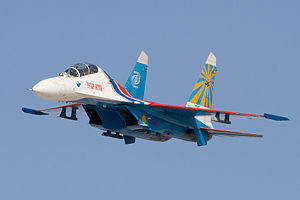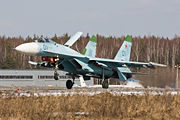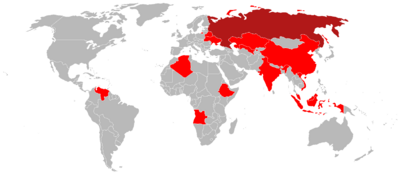Sukhoi Su-27
| Su-27 | |
|---|---|
 |
|
| Su-27UB of the Russian Knights aerobatic team | |
| Role | Air superiority fighter |
| Manufacturer | Sukhoi Design Bureau |
| First flight | 20 May 1977 |
| Introduced | December 1984 |
| Status | In production/in service |
| Primary users | Russian Air Force Chinese Air Force Ukrainian Air Force Indian Air Force |
| Produced | 1984-current |
| Number built | 680 |
| Unit cost | US$35 million |
| Variants | Su-30 Su-33 Su-34 Su-35 Su-37 Shenyang J-11 |

The Sukhoi Su-27 (Су-27 in the Cyrillic alphabet) (NATO reporting name ‘Flanker’) is a jet fighter plane originally manufactured by the Soviet Union, and designed by the Sukhoi Design Bureau. It was intended as a direct competitor for the new generation of American fighters (which emerged as the F-14 Tomcat, F-15 Eagle, F-16 Fighting Falcon, and F/A-18 Hornet), with long range, heavy armament, and very high agility. The Su-27 most often flies air superiority missions, but is able to perform almost all combat operations. Its closest American counterpart is the F-15 Eagle.
From the Su-27 design came several related developments. The Su-33 ‘Flanker-D’ is a Fleet Defense Interceptor that was developed from the Su-27 design for use on aircraft carriers. The main differences include a tail hook and canards. The Su-30 is a two-seat, dual-role fighter for all-weather, air-to-air and deep interdiction missions. Further versions include the Su-34 ‘Fullback’ strike variant and the Su-35 ‘Flanker-E’ improved air defense fighter.
Contents |
Development
Background
In 1969 the Soviet Union learned of the United States Air Force’s selection of McDonnell Douglas to produce the Fighter Experimental design (which was to become the F-15 Eagle). In response to that upcoming threat, the Soviets instituted the PFI (perspektivnyi frontovoy istrebitel, Advanced Frontline Fighter) program for an aircraft that could match the new American fighter on its own terms.
When the specification proved too challenging and costly for a single aircraft in the number needed, the PFI specification was split into two: the LPFI (Lyogkyi PFI, Lightweight PFI) and the TPFI (Tyazholyi PFI, Heavy PFI). THE LPFI program resulted in the MiG-29, a relatively short-range tactical fighter, while the TPFI program was assigned to Sukhoi OKB, which eventually produced the Su-27 and its various derivatives. The TPFI program is similar to the American F-X program, which resulted in the F-15 Eagle, while the LPFI program is similar to the LWF program, which spawned the F-16 Fighting Falcon and the Northrop YF-17, which itself led to the F/A-18 Hornet.
Design phase
The Sukhoi design, which was altered progressively to reflect Soviet awareness of the F-15's specifications, emerged as the T-10 (Sukhoi's 10th delta wing design), which first flew on 20 May 1977. The aircraft had a large delta wing, clipped, with two separate podded engines and a twin tail. The ‘tunnel’ between the two engines, as on the F-14 Tomcat, acts both as an additional lifting surface and hides armament from radar. While being developed, it was spotted by a spy satellite at the Zhukovsky flight test center near the town of Ramenskoe, resulting in the temporary codename of Ram-K. It was believed that the Ram-K was being developed in two versions: a swing-wing fighter similar in function to the Grumman F-14 and a two-seat fixed wing interceptor aircraft which in fact turned out to be the unrelated Mikoyan MiG-31.

The T-10 was spotted by Western observers and assigned the NATO reporting name ‘Flanker-A’. The development of the T-10 was marked by considerable problems, leading to a fatal crash on 7 May 1978. Extensive redesigns followed, and a heavily revised version, the T-10S, made its first flight on 20 April 1981. This, too, had considerable developmental problems, leading to another fatal crash on 23 December 1981.
The production Su-27 (sometimes Su-27S, NATO designation 'Flanker-B') began to enter VVS operational service around 1984, although manufacturing difficulties kept it from appearing in strength until 1986. The Su-27 served with both the PVO and Frontal Aviation. In V-PVO service it was primarily an interceptor, supplanting older aircraft like the Sukhoi Su-15 and Tupolev Tu-28. Although the ‘Flanker’ has some capacity to carry air-to-ground weapons, in Frontal Aviation service its primary role was neither air support nor battlefield air superiority--it was intended as a sort of aerial interdictor, tasked with fighting its way past enemy (presumably NATO) lines to strike tanker and AWACS aircraft. Soviet planners knew that NATO forces possessed a considerable advantage because of these assets, and believed that attacking them directly would limit NATO’s ability to maintain an extended air campaign. The Su-27 retains that role in CIS service, with later marks being equipped to carry the new Novator KS-172 AAM-L long-range anti-AWACS missile.
From 1986 a special Su-27 designated P-42, rebuilt from the prototype T-10S-3 aircraft and stripped to minimum weight, began to set the first in a series of performance records for rate of climb and altitude, the aircraft setting 27 new class records between 1986 and 1988.
Design


The Su-27’s basic design is aerodynamically similar to the MiG-29, but it is substantially larger. It is a very large aircraft, and to minimize its weight its structure has a high percentage of titanium (about 30%, more than any of its contemporaries). No composite materials were used. The swept wing blends into the fuselage at the leading edge extensions and is essentially a delta, although the tips are cropped for wingtip missile rails or ECM pods. The Su-27 is not a true delta, however, because it retains conventional tailplanes, with two vertical tailfins outboard of the engines, supplemented by two fold-down ventral fins for additional lateral stability.
The Su-27’s Lyulka AL-31F turbofan engines are widely spaced, both for safety reasons and to ensure uninterrupted airflow through the intakes. The space between the engines also provides additional lift, reducing wing loading. Movable guide vanes in the intakes allow Mach 2+ speeds, and help to maintain engine airflow at high alpha. A mesh screen over each intake prevents debris from being drawn into the engines during take-off.
The Su-27 had the Soviet Union’s first operational fly-by-wire control system, developed based on Sukhoi OKB’s experience in the Sukhoi T-4 bomber project. Combined with relatively low wing loading and powerful basic flight controls, it makes for an exceptionally agile aircraft, controllable even at very low speeds and high angles of attack. In airshows the aircraft has demonstrated its maneuverability with a Cobra (Pugachev’s Cobra) or dynamic deceleration — briefly sustained level flight at a 120° angle of attack. Thrust vectoring has also been tested (and is incorporated on later Su-30MKI and Su-37 models), allowing the fighter to perform hard turns with almost no radius, incorporate vertical somersaults into level motion and limited nose-up hovering.
The naval version of the ‘Flanker,’ the Su-27K (or Su-33), incorporates canards for additional lift, reducing take-off distances (important because the aircraft carrier Admiral Kuznetsov has no catapults). These canards have also been incorporated in some Su-30s, the Su-35, and the Su-37.
In addition to its considerable agility, the Su-27 uses its substantial internal volume for a large internal fuel capacity. In an overload configuration for maximum range, it can carry 9,400 kg (20,700 lb) of internal fuel, although its maneuverability with that load is limited, and normal load is 5,270 kg (11,620 lb).
The Su-27 is armed with a single Gryazev-Shipunov GSh-30-1 30 mm cannon in the starboard wingroot, and has up to 10 hardpoints for missiles and other weapons. Its standard missile armament for air-to-air combat is a mixture of Vympel R-73 (AA-11 Archer), Vympel R-27 (AA-10 'Alamo') weapons, the latter including extended range and IR guided models. More advanced Flanker variants (such as Su-30, -35, -37) may also carry Vympel R-77 (AA-12 Adder) missiles.
The Su-27 has a high-contrast tuneable HUD and a helmet-mounted sight capability, which, paired with the R-73 missile and the plane's superb agility make it one of the world's best dogfighter aircraft.
The radar proved to be a major developmental problem for the Su-27. The original Soviet requirement was very ambitious, demanding a multi-target engagement capability and 200 km range against "bombers" (16 sq.m RCS to match a Tu-16). This would greatly exceed the detection range of the F-15’s APG-63 (about 180 km vs a 100 sq.m RCS target) and be broadly comparable to the 1-ton Zaslon phased array radar used on the MiG-31.
To achieve this at a reasonable weight, the design team came up with a radar using electronic scanning for elevation and mechanical scanning for azimuth. Unfortunately, it proved too much for the Soviet microelectronics industry in the 1970s to achieve, and by 1982, the original Myesch program had to be abandoned and a less capable alternative array was selected. To make up the lost time, many matured technologies from the N019 Topaz radar, including an enlarged version of the twist-cassegraine array, on the MiG-29 was used, and as a result, the resulting N001 radar shared the same TS100 signal processor used on N019 Topaz radar, while N001V, the successor of N001, shared the same TS101M signal processor with N019M, the successor of N019. The radar only achieved a 140 km detection range versus the Tu-16, and could only engage a single target. Even then, the radar was initially beset by reliability problems and this caused the N001 to be accepted for service in 1991, half a decade after the Su-27 first entered service in 1986.
The first of the N001 series radar, the Tikhomirov (NIIR) N001 (NATO ‘Slot Back’), is a pulse-Doppler set with track-while-scan capability, but its processor is relatively primitive, making it vulnerable to false alarms and blind spots, as well as being more difficult to use. During the years, under the chief designer of N001 radar, Professor Viktor Konstantinovitch Grishin, the N001 radar has been upgraded many times, resulting in derivatives including N001V, N001VE, N001VEP, all of which are in service, including those exported Flankers. Professor V.K. Grishin was the chief designer of Zalson S-800 passive phased array radar on MiG-31, and the expertise would later contribute to the design of the replacement phased array radars for the N001 series.

It was apparent that there was limited room for improvement in the N001 series radar, and the Su-30 and Su-35/37 aircraft have the vastly superior Tikhomirov (NIIR) 'Bars' (Panther) N011M with a passive electronically scanned array, improving range, multiple target capability, and sensitivity. The Bars (Panther) radar is scheduled to be replaced by an even more capable successor, Irbis (Snow leopard)-E phased array radar in the near future. Tikhomirov (NIIR)’s competitor, Phazotron (NIIP) also offered similar radar with passive electronically scanned array.
The Su-27 has an infrared search and track (IRST) system in the nose just forward of the cockpit, which also incorporates a laser rangefinder. This system can be slaved to the radar, or used independently for "stealthy" attacks with infrared missiles (such as the R-73 and R-27T/ET). It also controls the cannon, providing greater accuracy than a radar sighting mode.
While the Su-27 and its immediate descendants (Su-35 and -37) have outstanding maneuverability and performance, the airframe design lacks stealth features, so the radar cross section (RCS) is large.
Operational history

The Su-27 has seen limited action since it first entered service. Ethiopian Su-27s reportedly shot down five Eritrean MiG-29s;[1] in February 1999 and another on May 16, 2000.[2][3] The Su-27s were also used in CAP (Combat Air Patrol) missions, suppression of air defense, and providing escort for fighters on bombing and reconnaissance missions.[4]
In Angolan service, one Su-27 was shot down by a SA-14 MANPADS fired by UNITA forces on November 19th, 2000. Angolan Su-27 entered service in mid 2000.[1][5]
Recently, in the 2008 South Ossetia War, Russia was using Su-27s to gain airspace control over Tskhinvali, the capital city of South Ossetia.[6][7]
Variants
Soviet-era


- T10 ("Flanker-A"): Initial prototype configuration.
- T10S: Improved prototype configuration, more similar to production spec.
- P-42: Special version built to beat climb time records. The aircraft had all armament, radar and paint removed, which reduced weight to 14,100 kg. It also had improved engines.
- Su-27 Preproduction series built in small numbers with AL-31 engine
- Su-27S (Su-27 / "Flanker-B"): Initial production single-seater with improved AL-31F engine. The "T10P" designation is sometimes used for Su-27S single-seaters stripped of secondary strike capability.
- Su-27UB ("Flanker-C"): Initial production two-seat operational conversion trainer.
- Su-27SK: Export Su-27 single-seater.
- Su-27UBK: Export Su-27UB two-seater.
- Su-27K (Su-33 / "Flanker-D"): Carrier-based single-seater with folding wings, high-lift devices, and arresting gear, built in small numbers. They followed the "T10K" prototypes and demonstrators.
Post-Soviet era
- Su-27PD: Single-seat demonstrator with improvements such as inflight refueling probe.
- Su-27PU (Su-30): Two-seat limited production machine with improvements such as inflight refueling probe, fighter direction avionics, new flight control system, and so on.
- Su-30M / Su-30MK: Next-generation multirole two-seater. Apparently a few Su-30Ms were built for Russian evaluation in the mid-1990s, though nothing much came of the effort. The Su-30MK export variant was embodied as a series of two demonstrators of different levels of capability.
- Su-30MKA: Export version for Algeria.
- Su-30MKI (Flanker-H): Substantially improved Su-30MK for the Indian Air Force, with canards, vectored-thrust engines, new avionics provided by several nations, and multirole capability.
- Su-30MKK (Flanker-G): Su-30MK for the Chinese air force, with updated Russian-built avionics and multirole capability, but no canards or thrust-vectoring engines. The Chinese navy also bought similar "Su-30MK2" machines with enhanced antishipping attack capabilities.
- Su-30MKM: A copy of Su-30MKI with special configuration for Malaysia.
- Su-30KN (Flanker-B Mod. 2): Improved single-seater that features new electronics that allow the Su-30KN to perform new functions, most concerning navigation.
- Su-30KI (Flanker-B Mod. 2): Improved single-seater with Su-30MK features for Indonesia deal that fell through, following in the steps of an "Su-27SMK" evaluation aircraft flown in the mid-1990s.
- Su-27M (Su-35 / 37, Flanker-E/F): Series of improved demonstrators for an advanced single-seat multirole Su-27S derivative. The series also included a two-seat "Su-35UB" demonstrator.
- Su-27SM (Flanker-B Mod. 1): Upgraded Russian Su-27S, featuring technology evaluated in the Su-27M demonstrators.
- Su-27SKM: Single-seat multirole fighter for export. It is a derivative of the Su-27SK but includes upgrades such as advanced cockpit, more sophisticated self-defense electronic countermeasures (ECM) and an in-flight refueling system.[8]
- Su-27UBM: Comparable upgraded Su-27UB two-seater.
- Su-32 (Su-27IB): Two-seat dedicated long-range strike variant with side-by-side seating in "platypus" nose. Prototype of SU-32FN and Su-34 Fullback
- Su-27KUB: Essentially an Su-27K carrier-based single-seater with a side-by-side cockpit, for use as a naval carrier trainer or multirole aircraft.
- Su-27BM (Su-35): Also dubbed "The Last Flanker" is latest development from Sukhoi Flanker Family. It feature newer avionics and new radar. The Irbis-E high power PESA radar with capability to track 3 m RCS target at 400 km and 0.01 m RCS at 90 km.
Operators


Around 680 Su-27s were manufactured by the Soviet Union and Russia. This total includes only Su-27s and not later derivative aircraft.
 Algeria
Algeria - 8 Su-30MKA delivered. The contract stipulates 28 aircraft by 2010.[9][10]
 Angola
Angola - About 8 Su-27 and 27UB.[10]
 Belarus
Belarus - Possibly 25 in service.
 People's Republic of China
People's Republic of China - China acquired 76 Su-27 fighters from Russia before signing an agreement in 1998 to redesign China's own versions of the plane as the Shenyang J-11 (about 100 have been built by 2004). By 2006, China also purchased 100 Sukhoi Su-30MKK/MK2 (Modernizirovannyi Kommercheskiy Kitaiskiy - upgraded commercial [version] for China) for the People's Liberation Army Air Force and 48 Sukhoi Su-33 for PLANAF's future carrier fighter.
 Eritrea
Eritrea - About 8 Su-27SK/27UB went to Eritrea in 2003.[10]
 Ethiopia
Ethiopia - The EtAF operates 11 Su-27SK, 3 Su-27P, and 4 Su-27UB[10]
 Indonesia
Indonesia- Indonesia has 2 Su-27SK and 2 Su-30MK in order to replace their old A-4 Skyhawk. In 2007-2009, the Indonesian Air Force will receive 3 Su-27SKM and 3 Su-30MK2 to expand their Su-27s to be a squadron. Indonesian Su-27 has been seen on live fire exercise delivering o-fab bombs.[10]
 Kazakhstan
Kazakhstan- operates around 30 and is due a further twelve under agreement.[10]
 Malaysia
Malaysia- Malaysia ordered 18 Su-30MKM in 2003 worth US$900 million expecting deliveries in 2006. The Su-30MKM is equipped with the latest missiles to include a variety of the AA-10 missiles, AA-12 and AA-11 as well as a complete range of air to ground weapons to include guided and unguided missiles and bombs. Malaysia's aircraft come equipped with canards and thrust vectoring engines for high agility.[10]
 Russia
Russia- 449 are in service with the Russian Air Force.[11] Russia presently plan to upgrade their aircraft to the Su-27SM standard, which will include a glass cockpit and a change to digital fly-by-wire. The radar is to be upgraded with a phased array (most likely Pero) allowing increased range. The self defense and navigation suites will also be upgraded, as well as an attack suite. They hope this will be completed by 2008. Besides the Su-27s, Russia also has 19 Su-30, 28 Su-33, 30 Su-34 and 11 Su-35.
 Ukraine
Ukraine- The Ukrainian Air Force has 80 in service.[12]
 Uzbekistan
Uzbekistan- has 25 in service.[10]
 Vietnam
Vietnam- Vietnam People's Air Force has twelve Su-27SK and has ordered a further 24.[10]
 United States
United States- Two Su-27s were delivered to the United States in 1995, probably for aggressor training.[13][10]
Former Operators
 Soviet Union
Soviet Union- Soviet Air Force and Soviet Anti-Air Defence
Specifications (Su-27)

Data from KNAAPO Su-27SKM page,[14] Sukhoi Su-27SK page,[15] Gordon and Davison[16]
General characteristics
- Crew: One
- Length: 21.9 m (72 ft)
- Wingspan: 14.7 m (48 ft 3 in)
- Leading edge sweep: 42°)
- Height: 5.93 m (19 ft 6 in)
- Wing area: 62 m² (667 ft²)
- Empty weight: 16,380 kg (36,100 lb)
- Loaded weight: 23,000 kg (50,690 lb)
- Max takeoff weight: 33,000 kg (62,400 lb)
- Powerplant: 2× Saturn/Lyulka AL-31F turbofans, 122.8 kN (27,600 lbf) each
Performance
- Maximum speed: Mach 2.35 (2,500 km/h, 1,550 mph) at altitude
- Range: 3,530 km (2,070 mi) at altitude; (1,340 km / 800 mi at sea level)
- Service ceiling 18,500 m (60,700 ft)
- Rate of climb: 325 m/s (64,000 ft/min)
- Wing loading: 371 kg/m² (76 lb/ft²')
- Thrust/weight: 1.09
Armament
- 1x 30 mm GSh-30-1 cannon with 150 rounds
- 8,000 kg (17,600 lb) on 10 external pylons
- Up to 6 medium-range AA missiles R-27, 4 short-range heat-seeking AA missiles R-73
- Upgraded Su-27SM is capable of using R-77 instead of R-27
- Su-27IB can be used to launch X-31 anti-radiation missiles, air-to-ground missiles X-29L/T (laser/TV guidance, which may be projected to helmet), KAB-150 and UAB-500 bombs with laser, TV, or IR guidance
- Up to 6 medium-range AA missiles R-27, 4 short-range heat-seeking AA missiles R-73
Su-27S armament
- GSH-30 30 mm Cannon, 150 rounds
- 6x R-27R, R-27ER, R-27T, R-27ET
- 4x R-73E
- FAB-250
- FAB-500
- B-8
- B-13
- S-24
- S-25
Incidents and accidents
- September 9, 1990: Salgareda Air Show, Italy, 2 killed (pilot Rimantas Stankevičius + 1 spectator).
- July 27, 2002: Sknyliv airshow disaster at Lviv, Ukraine - 85 spectators killed.[17](Video)
- July 29, 2008: crashed on a training flight in Primorye Territory, Russia at 07:30GMT, 1 pilot killed the other survived[18]
Popular culture

The Su-27 is in a starring role in the SSI flight simulator game Su-27 Flanker.
It also appears in the sequel Lock On, in fact in this game among other aircraft you can fly the SU-27 Flanker B and the naval variant SU-33 Flanker D.
See also
Related development
- Sukhoi Su-30
- Sukhoi Su-33
- Sukhoi Su-34
- Sukhoi Su-35
- Sukhoi Su-37
- Sukhoi Su-47
- Shenyang J-11
Comparable aircraft
References
- ↑ 1.0 1.1 "Su-27 operations". Milavia.
- ↑ "Air Aces".
- ↑ Claims with No Names, Air Aces page.
- ↑ "ke bahru be chilfa" (Ethiopian Air Force 2007 graduation publication, May 2007), pp. 72–3
- ↑ "Moscow Defense Brief".
- ↑ Lenta.Ru: Georgian army forces falling back from Tskhinvali (Russian)
- ↑ Lenta.Ru: Russian airplanes are bombing Georgian army positions (Russian)
- ↑ KNAAPO - Production - Defense - Su-27SKM
- ↑ "Russia delivers two Su-30 fighters to Algeria". GlobalSecurity.org (2008-06-02). Retrieved on 2008-11-20.
- ↑ 10.0 10.1 10.2 10.3 10.4 10.5 10.6 10.7 10.8 10.9 Niels Hillebrand (2008-10-11). "Su-27 Flanker Operators List". MILAVIA. Retrieved on 2008-10-12.
- ↑ SU-27 Flanker air superiority fighter, warfare.ru
- ↑ "World Military Aircraft Inventory", Aerospace Source Book 2007, Aviation Week & Space Technology, January 15 2007.
- ↑ Gordon and Davison 2006. p. 101.
- ↑ Sukhoi Su-27SKM, KNAAPO.
- ↑ Su-27SK Aircraft performance page, Sukhoi.
- ↑ Gordon and Davison 2006, pp. 92, 95-96.
- ↑ "Pilots blamed for air show crash", CNN (7 August 2002).
- ↑ "Su-27 Flanker fighter crashes in Russia's Far East, 1 pilot dead", RIA Novosti (July 29, 2008).
- Gordon, Yefim and Peter Davison. Sukhoi Su-27 Flanker, Specialty Press, 2006. ISBN 978-1-58007-091-1.
- Modern Combat Aircraft: Reference guide pp. 50-51 Minsk, "Elida", 1997, ISBN 985-6163-10-2. (Russian)
- Comprehensive Russian Military Analysis, warfare.ru.
External links
- http://www.knaapo.ru/eng/
- http://www.irkut.com/en/
- Russkiye Vityazi (Russian Knights) Acrobatic Team
- GlobalSecurity.org
- Sukhoi Su-27 page by the Federation of American Scientists
- Sukhoi Flankers - The Shifting Balance of Regional Air Power
- The Su-27SKM
- Su-27SК Sukhoi
- Su-27SК Russia Military Analysis
- Asia's Advanced Flankers
- Su-27 free walkaround (37 shots)
|
||||||||||||||||||||
|
||||||||||||||